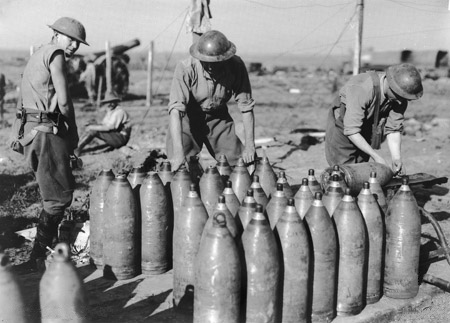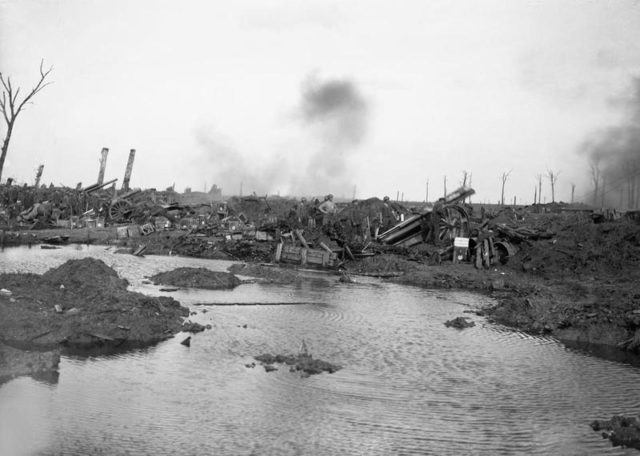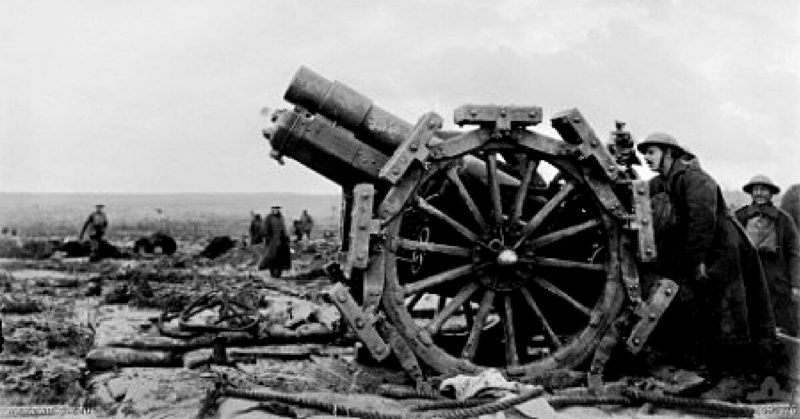The name Passchendaele sounds as though it should refer to a place of great beauty. It evokes a sense of romance and the peace of rural life.
However, Passchendaele in the period during the First World War was hell on earth. The last ridge east of Ypres, close to a strategic railway junction, in 1917 it was on the line of the Western Front. Held by the Germans, the Allies repeatedly assaulted it. In Britain, it became synonymous with the horrifying brutality of trench warfare.
The term “Battle of Passchendaele” is confusingly used to refer to both a month-long campaign and two battles within it. Each of these played some part in earning the ridge its bloody reputation.
Battles Within Battles
Before the First World War, each battle within a campaign was usually a distinct engagement. Sieges might include raids and sorties, but the boundaries between engagements were clear. Armies clashed, separated, and moved on to the next confrontation.
World War One was different. On the Western Front, vast armies sat facing each other for four years. Sporadic fighting was the background to life in the trenches. With military engagements seldom as decisive as the commanders expected, a single battle could drag on for days or weeks.
There were battles within battles in the war. What we call the Battle of the Somme was a four-and-a-half-month offensive that included over a dozen smaller battles, including Delville Wood, Morval, and Thiepval Ridge. A soldier could be fighting in several battles at once.
This was particularly confusing at Passchendaele.

The Battle of Passchendaele
The term “Battle of Passchendaele” is often used to refer to the Third Battle of Ypres. It was the main British offensive of 1917. Like previous British assaults near the town of Ypres, it was an attempt to seize high ground that overlooked the town on three sides.
Launched on July 31 and lasting until the middle of November, the offensive had three phases. First, the Fifth Army expanded the salient in a series of grueling advances through ground churned to mud by artillery and rain. Then the Second Army took over, making progress in the center of the salient, bringing Field Marshal Haig some of the success he sought. Finally came a period of fighting on the north-east side of the salient, as Australian, British, and Canadian troops pushed their way up the ridges at Passchendaele and Poelcappelle.
It was during this final phase that the First and Second Battles of Passchendaele took place.
The First Battle of Passchendaele
The third phase of the Third Battle of Ypres began on October 12 with what would become known as the First Battle of Passchendaele.
The day got off to a bad start. The foul weather had made the ground difficult to advance across. It also conspired to keep aircraft from acting as spotters over the German lines. As a result, the artillery had trouble targeting the Germans. Even when they hit the right areas, shells sank deep into the mud. When they exploded it was with a fountain of ooze but little impact on the barbed wire and German defenses. The mud also prevented guns being brought up to cover the infantry advance.
What followed was a series of futile attacks.
The 4th Australian Division tried to advance along the ridge to Passchendaele but achieved little.
Left of them, the 3rd Division suffered heavy losses. Their 34th Battalion was devastated by German shelling. The 35th Division overran Augustus Wood and reached the ridge, where they found scattered British troops hanging on from an attack the day before. They reached Passchendaele, but in such small numbers, they could not hold the village against German counter-attacks.
New Zealanders advancing from Waterloo ran into dense barbed wire almost untouched by the shelling. Unable to advance, they were mown down by German machine-guns.
Advances around Poelcapelle and Houthulst Forest were equally ineffective.
The First Battle of Passchendaele had been a wasteful disaster.
The Second Battle of Passchendaele
The Second Battle of Passchendaele was more protracted.
Canadian troops, who had extensive experience fighting around Ypres, were brought up to the battle zone for this attack. They were led by one of their own, Lieutenant-General Sir Arthur Currie.
The Allies had prepared for this attack with four days of shelling against German positions. The Germans had also prepared. After recent British successes, they had changed their defensive tactics. Front lines were thinly defended, with stronger concentrations of troops in the second line. Artillery was arranged to bombard the forward positions as soon as they had fallen.
Currie launched his attack on October 26.

The Canadian 46th Battalion, supported by the Australian 18th Battalion, advanced up Passchendaele Ridge in a mist that slowly turned to rain. They suffered 70% casualties but took their objectives.
On Bellevue Ridge, the Canadians fought a brutal back-and-forth action. They cleared out pillboxes using grenades but suffered from shell fire as the Germans used their new tactics. A day of severe fighting, taking one pillbox at a time left them in control of German positions that had previously repelled British and New Zealand attacks.
Currie waited three days before making a second push on October 30. More ground was taken, again with heavy losses. German counter-attacks followed and were fought off by the Allies.
On November 6, the Canadians advanced again. While the British created a distraction on their flank, the 27th Battalion, 6 Brigade, 2nd Canadian Division, raced toward Passchendaele. They reached the village so quickly the Germans were caught by surprise, their machine-guns unmanned. At last the village and the ridge were taken.
A final advance on November 10 saw Canadian and British troops make Passchendaele secure. The Germans bombarded the place remorselessly for four days but were unable to dislodge the Canadians.
One extended offensive and two battles within it all bore the name of Passchendaele. All were bloody, muddy, and horrific. Ultimately, they brought the Allies the successes they wanted; at a tremendous cost in lives.
Sources:
Martin Marix Evans (2002), Over the Top: Great Battles of the First World War.
Richard Holmes, ed. (2001), The Oxford Companion to Military History.
